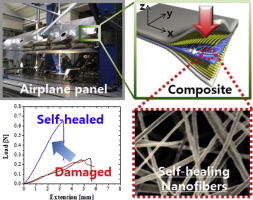Advances in Colloid and Interface Science ( IF 15.6 ) Pub Date : 2017-12-24 , DOI: 10.1016/j.cis.2017.12.010 Min Wook Lee , Seongpil An , Sam S. Yoon , Alexander L. Yarin

|
Here, we review the state-of-the-art in the field of engineered self-healing materials. These materials mimic the functionalities of various natural materials found in the human body (e.g., the healing of skin and bones by the vascular system). The fabrication methods used to produce these “vascular-system-like” engineered self-healing materials, such as electrospinning (including co-electrospinning and emulsion spinning) and solution blowing (including coaxial solution blowing and emulsion blowing) are discussed in detail. Further, a few other approaches involving the use of hollow fibers are also described. In addition, various currently used healing materials/agents, such as dicyclopentadiene and Grubbs' catalyst, poly(dimethyl siloxane), and bisphenol-A-based epoxy, are described. We also review the characterization methods employed to verify the physical and chemical aspects of self-healing, that is, the methods used to confirm that the healing agent has been released and that it has resulted in healing, as well as the morphological changes induced in the damaged material by the healing agent. These characterization methods include different visualization and spectroscopy techniques and thermal analysis methods. Special attention is paid to the characterization of the mechanical consequences of self-healing. The effects of self-healing on the mechanical properties such as stiffness and adhesion of the damaged material are evaluated using the tensile test, double cantilever beam test, plane strip test, bending test, and adhesion test (e.g., blister test). Finally, the future direction of the development of these systems is discussed.
中文翻译:

基于具有机械自修复特性的血管网络的自愈材料的研究进展
在这里,我们回顾了工程自修复材料领域的最新技术。这些材料模仿了人体中各种天然材料的功能(例如,通过血管系统治愈皮肤和骨骼)。详细讨论了用于生产这些“类似血管系统”的自修复材料的制造方法,例如电纺丝(包括共电纺丝和乳液纺丝)和溶液吹塑(包括同轴溶液吹塑和乳液吹塑)。此外,还描述了其他一些涉及使用中空纤维的方法。另外,描述了各种当前使用的愈合材料/试剂,例如二环戊二烯和Grubbs的催化剂,聚(二甲基硅氧烷)和双酚A基环氧树脂。我们还回顾了用于验证自我修复的物理和化学方面的表征方法,即用于确认已释放出治愈剂并导致其治愈的方法,以及在治疗中诱导的形态变化。修复剂损坏的材料。这些表征方法包括不同的可视化和光谱技术以及热分析方法。要特别注意自我修复的机械后果的表征。使用拉伸测试,双悬臂梁测试,平面剥离测试,弯曲测试和附着力测试(例如起泡测试)评估自我修复对机械性能(如刚度和受损材料的附着力)的影响。最后,



























 京公网安备 11010802027423号
京公网安备 11010802027423号